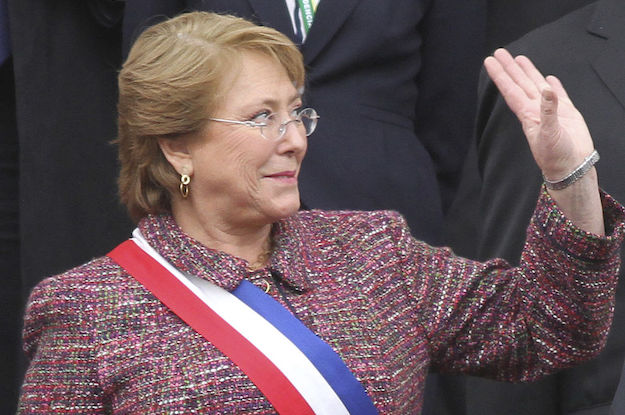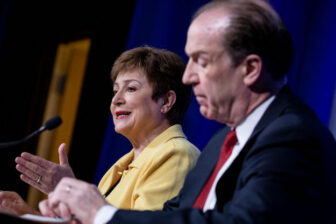As Latin America wrestles with the pandemic and its worst economic crisis in more than a century, political leadership rests in the hands of male leaders in every single one of its 20 countries. Just as troubling, Latin America has not elected a single woman president in the last seven years.
Amid reports of glaring COVID-19 mismanagement ranging from Mexico all the way down to Brazil, one cannot help but recall Cindy Gallop and Tomás Chamorro-Premuzic’s famous insight: “The real problem is not a lack of competent females, but rather too few obstacles for incompetent males.”
It was not always so. As recently as 2014, the region had four female presidents at the same time. But today, beyond the damage from the pandemic, the lack of female leadership at the highest levels of government cannot be overlooked. It is both a measure of structural exclusion and a flaw in one of democracy’s central pillars: representation. It is no coincidence that, according to the latest Latinobarómetro survey, dissatisfaction with the quality of democracy in Latin America now sits at its highest level since the mid-1990s, and that Latin Americans find themselves once again entertaining the merits of authoritarian models.
It seems reasonable to wonder if, had women been in charge in Latin American countries during this pandemic, they might have followed a path closer to Angela Merkel’s, embracing science while working to build consensus around social distancing and other prudent measures. Perhaps they would have displayed more empathy toward vulnerable groups including women, whom studies show have been forced out of the workforce in higher numbers than men. What is clear is that, when women are left out of political leadership, our governments cannot fully achieve economic, political and social progress.
So: How did we get here? Throughout modern history, Latin America has had 11 female presidents. That is of course 11 more than the United States. But half of them rose to power under extraordinary circumstances and constitutional ruptures. It is instructive to consider their stories, what they have in common, and what they tell us about today’s unfortunate lack of representation.
María Estela Martínez de Perón, best known as “Isabel” Perón, was not only the first female president of Latin America but the first female president of any republic in the world. As vice president of Argentina in 1974, Perón rose to power upon the death of then-husband and President Juan Domingo Perón. Criticized for her lack of experience in government affairs — something true of countless men that have held the same office — Perón came to power in a context of extreme economic crisis, strikes and paramilitary activities supported by the government. She was deposed in a coup and arrested after 632 days in office.
Three years later, in November 1979, also under a highly unstable political environment, Lidia Gueiler was elected Bolivia’s Constitutional Interim President. On top of an assassination attempt, Gueiler faced a complex socioeconomic scenario: As part of her stabilization plan, Gueiler allowed a 25% devaluation in the peso and cancelled energy subsidies, exacerbating existing social tensions. No candidate succeeded in winning a majority in the 1980 elections, and a coup toppled Guelier from power later that year.
A decade later, Violeta Barrios Torres — best known by her husband’s last name, Chamorro — became the first woman in the Americas to be elected president. She governed Nicaragua over a tumultuous seven-year period, in which she would disarm and offer peace to the Contras, combat four-digit inflation, restructure one of the highest per-capita foreign debts in the region and negotiate a large foreign aid package from the U.S.
In 1997, three different figures claimed Ecuador’s presidency, one of them Vice President Rosalía Arteaga, who held the temporary presidency less than a week (Feb. 9-11). When Congress voted to remove then-President Abdalá Bucaram, the latter insisted he had been illegally overthrown. Per the Constitution, Arteaga should have assumed power and called new elections, but Congress decided to name its own leader, Fabián Alarcón, as interim president, thus triggering “the night of the three presidents.” After assuming power via decree, Arteaga chose to resign two days later rather than allowing Congress to remove her from office.
Two years later, Mireya Moscoso was elected president of Panama. During her five-year term, Moscoso, who had lost a 1993 presidential run by a 4% margin, would manage the return of the Panama Canal from the U.S. as well as the fallout from the resignation of her entire cabinet. She would also sign off on Panama’s founding membership in the Central American Integration System (SICA) — still a hallmark political and economic agreement in the region — and ensure Panama a seat in the Central American Parliament (PARLACEN).
Michelle Bachelet first became president of Chile in 2006 before winning a second nonconsecutive mandate from 2014 to 2018 with 62% of votes. Although her two mandates vary largely in context and priorities, both administrations placed a clear emphasis on social issues — everything from education and labor reforms to abortion and civil unions — and the transformation of Chile’s energy matrix, with renewables’ share of the energy supply surging from 5% to more than 20% under her watch.
Cristina Fernández de Kirchner governed Argentina from 2007 to 2015. The current vice president of the country was Argentina’s first elected woman president and the first in Latin America to be reelected to a second term (2011). Despite being remembered by some as “the authoritarian populist,” as she herself wrote in her memoirs in 2019, and facing a series of corruption accusations, Kirchner represents a polarized but strong current in favor of the vindication of social rights in Argentina, including those of women.
In 2008, halfway into the mandate of her predecessor, Laura Chinchilla, then vice president of Costa Rica, resigned and announced she would run for president in 2010. After winning by a wide margin, she would go on to usher Costa Rica through its recovery from the global financial crisis, achieving one of the highest and most consistent growth rates in Central America during her tenure (4.4% on average). She managed this alongside one of the most drastic energy transitions in the region (renewables would account for 90% of energy production by the end of her mandate) and the implementation of a “citizen security” strategy that led to significant reductions in both criminality and homicides.
In 2011, Dilma Rousseff became the first woman to hold the presidency of the seventh-largest economy in the world and largest in the region. She committed to a virtuous circle of harnessing oil, boosting the economy and combating extreme poverty. After an average growth of 4.4% from 2004 to 2010, Brazil’s economy slowed abruptly and by the end, Rousseff’s 2011-2016 presidency was mired in the country’s worst recession in more than a century. Though Rousseff had edged out a win in a tight bid for reelection, she was impeached in 2016 due to an alleged violation of the budget law.
At the end of the decade, and as a result of a constitutional crisis, Mercedes Aráoz became acting president of Peru on Sep. 30, 2019. She presented her resignation the following day.
After the resignations of Evo Morales, his vice president and the rest of the officials in the line of succession, Second Vice President of the Senate Jeanine Áñez became interim president of Bolivia on Nov. 12, 2019. She declined to participate in the 2020 electoral process to avoid dividing votes from the opposition and was detained under sedition charges in March 2021 in what many view as political persecution by the current Morales-linked regime.
A lack of representation
After considering these cases, the number “11” must be seen in a different light. Given how many ascended to the job through circumstance and/or for a very short period, perhaps we have exaggerated, or been overly content with, the female representation we’ve had and not focused enough on the barriers that evidently still exist. Yes, Latin America has had several remarkable elected women presidents. But not enough, amidst the hundreds of men presidents.
To remedy this, we need a whole-of-society approach. Steps that support women in the workforce may eventually help produce more leaders in every field — including politics. Countries could also expand, and more rigorously enforce, the gender quotas for legislatures and other elected offices that have largely worked in Latin America over the past 30 years.
It is time to support women politicians in their quest to reach the highest political offices, removing barriers and interrupting the unacceptable status quo. It is time to allow women to fulfill their destinies and lead.







